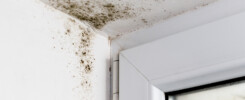Whenever you see an unsightly, discolored patch on a wall or ceiling, or smell something unpleasant in certain areas of your home the first thing you should ask yourself is, “Does my house have mold?”
For the sake of your own health, and that of your family, you should sharpen up your mold detection skills.
Not only can mold and water damage cause structural problems in your home and cost a lot of money to repair if left undetected, but molds can also have deleterious effects on your well-being.
Read on to see how you, too, can become a mold detective in the interests of protecting your health.
Mold Detection for Health Reasons
Molds, which are microscopic multicellular fungi, occur in nature and help to break down dead organic matter, such as fallen leaves. There is nothing wrong with them, as such. When temperature and moisture conditions are favorable, mold spores begin the reproductive process.
Many of these spores, which we cannot see with the naked eye, are airborne. If they land on wet or damp surfaces, they will begin to grow and reproduce.
There are three main categories of mold:
- Allergenic
- Pathogenic
- Toxigenic
While we all breathe in airborne mold spores, some people have an allergic reaction to the allergenic type of mold. Usually, the symptoms are much the same as reactions to other airborne allergens: itchy nose, sneezing, runny nose, masala congestion, and dry skin. In people prone to asthma, spores entering the lungs could trigger an asthmatic attack.
Pathogenic molds can cause infections in people, especially if they have compromised immune systems. They can cause chronic lung infections, cryptococcal meningitis, and pneumonia.
The metabolism of toxigenic molds is such that it can create chemical byproducts called mycotoxins. It is a misconception that the mold itself is toxic, a myth that keeps spreading like unchecked black mold. Mycotoxins can, however, become airborne and travel with mold spores.
There are roughly 500 recognized mycotoxins. Ingestion or inhalation of mycotoxins can cause toxicity. As a result of mycotoxicosis, you could develop cancer, or your liver, kidney, nervous system, or immune system could be affected.
How to Detect Mold In My House
The first hint that you might have mold in your home is if you exhibit any of the symptoms above. It is just as likely, though, that you will notice visible signs first.
Look in all the right places: every damp — or potentially damp —place in your home. Is there black in the grout of your bathroom or shower tiles or around the base of your faucets in the bathroom or kitchen? Are there dark spots or patches on the ceilings, floors, or fitted carpets?
Do cupboards or rooms smell musty? What about food that has gone bad and bold inside your refrigerator? Have you checked the hot water geyser for rust lately?
How about beneath the kitchen sink and the bathroom basins? Is your roof leaking? Can you hear water dripping on the ceiling boards?
Not all molds are black or green. Some are brown, and some appear white if there is moisture behind a coat of white paint. In all cases, cleaning it with household bleach will remove the discoloration and most or all of the mold. Wear a mask and gloves to prevent yourself from inhaling the mold while cleaning it up.
Mold Removal Service
The next step after mold detection is to get in the mold remediation and removal experts from Big Easy Restoration to find the source of the mold or water damage. We will fix the damage. We also provide a thorough disinfection and sanitation service, that is worth doing periodically, especially if you live in a tropical climate like the one in Florida.
We’re a State-licensed mold contractor. Have a look at our Portfolio on our website. Your home could look like the “after” pictures too!
Contact us by phone or e-mail today for a thorough home health check-up and remediation service.


